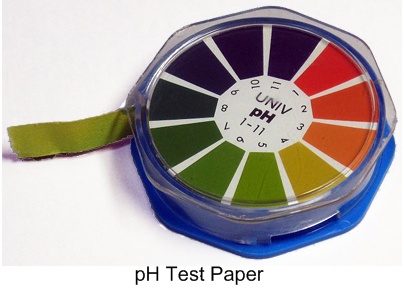A buffered solution generally contains several different solutes. At a minimum, it must contain both the acid and base components of the buffer. In addition, buffered solutions often contain other solutes such as nutrients, electrolytes, and/or various biomolecules. To prepare a buffer with specific concentrations of several different solutes, do a separate calculation to determine the amount of each solute needed (using the procedures you learned in Exercise #2), mix all of the solutes together, and then add enough solvent to bring the solution to its final volume.
 In addition to controlling solute concentrations, making a buffer also involves
controlling pH. The pH of a buffer is determined by the relative concentrations
of the acid and base components. For example, in lab you will be preparing an
acetate buffer. In this buffer, the acid component is acetic acid and the base
component is the acetate ion. As long as the concentrations of these 2
components are equal, the pH of the acetate buffer will be 4.6. Therefore, if
you prepare one acetate buffer where the concentration of each component is 50
mM and a second acetate buffer where the concentration of each component is 900
mM, both buffers will have a pH of 4.6. On the other hand, even though both
buffers will have the same pH, the second buffer will have a much higher
buffering capacity, meaning it will have a much greater ability to resist
changes in pH as additional acid or base is added to the buffer.
In addition to controlling solute concentrations, making a buffer also involves
controlling pH. The pH of a buffer is determined by the relative concentrations
of the acid and base components. For example, in lab you will be preparing an
acetate buffer. In this buffer, the acid component is acetic acid and the base
component is the acetate ion. As long as the concentrations of these 2
components are equal, the pH of the acetate buffer will be 4.6. Therefore, if
you prepare one acetate buffer where the concentration of each component is 50
mM and a second acetate buffer where the concentration of each component is 900
mM, both buffers will have a pH of 4.6. On the other hand, even though both
buffers will have the same pH, the second buffer will have a much higher
buffering capacity, meaning it will have a much greater ability to resist
changes in pH as additional acid or base is added to the buffer.It is also important to realize that as the relative concentration of the acid component of a buffer increases, the pH of the buffer will decrease. For example, an acetate buffer containing 88 mM acetic acid and 16 mM sodium acetate (a source of acetate ions) will have a pH of 3.8 (compared to a pH of 4.6 when both components have the same concentration.) On the other hand, as the relative concentration of the acid component of a buffer decreases, the pH of the buffer will increase. For example, an acetate buffer containing 21 mM acetic acid and 79 mM sodium acetate will have a pH of 5.2.